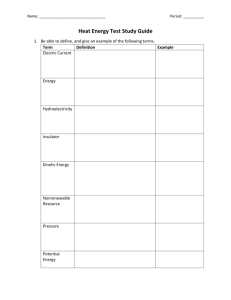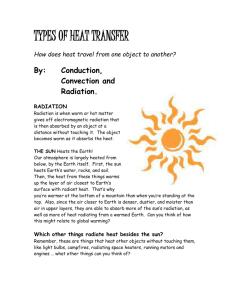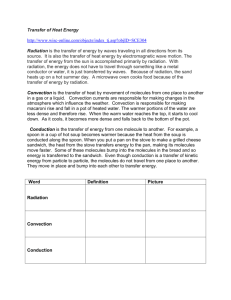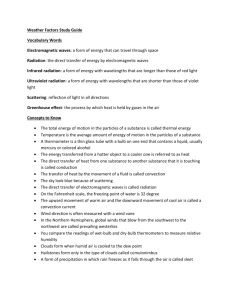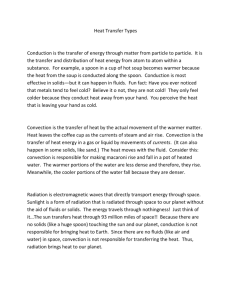Heat
advertisement
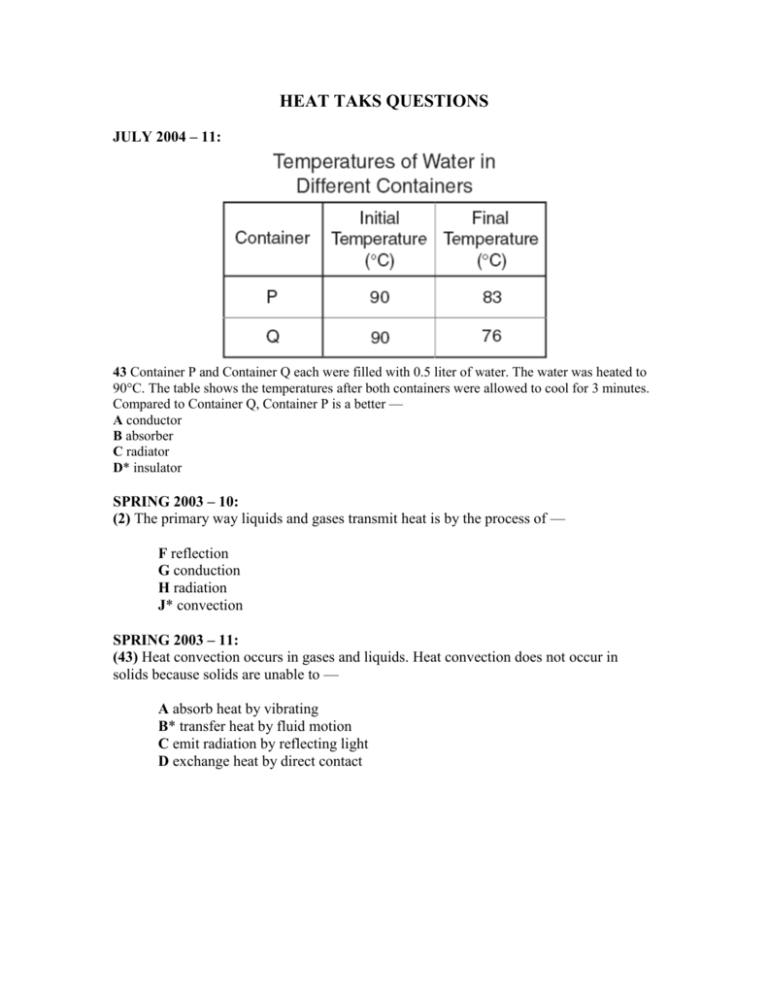
HEAT TAKS QUESTIONS JULY 2004 – 11: 43 Container P and Container Q each were filled with 0.5 liter of water. The water was heated to 90°C. The table shows the temperatures after both containers were allowed to cool for 3 minutes. Compared to Container Q, Container P is a better — A conductor B absorber C radiator D* insulator SPRING 2003 – 10: (2) The primary way liquids and gases transmit heat is by the process of — F reflection G conduction H radiation J* convection SPRING 2003 – 11: (43) Heat convection occurs in gases and liquids. Heat convection does not occur in solids because solids are unable to — A absorb heat by vibrating B* transfer heat by fluid motion C emit radiation by reflecting light D exchange heat by direct contact SPRING 2003 – 11: 50 A solar heater uses energy from the sun to heat water. The heater’s panel is painted black to — F improve emission of infrared radiation G reduce the heat loss by convection currents H* improve absorption of infrared radiation J reduce the heater’s conducting properties APRIL 2004 – 10: (33) A man who was sleeping wakes up because he hears the smoke alarm go off in his house. Before opening the bedroom door, the man feels the door to see whether it is warm. He is assuming that heat would be transferred through the door by — A* conduction B convection C radiation D compression APRIL 2004 – 11: Moon Chemistry Samples collected by Apollo astronauts have provided new data about the moon. Some of these samples consisted of lunar soil, a fine-grained, sand-like material produced as a result of the destruction of moon rocks. Traces of beryllium-10 were found in the samples. Beryllium-10 is carried by the solar wind, which transports elements from the sun’s surface and deposits them on the moon. The solar wind may also result in the formation of new substances. Tiny teardrops of iron and specks of molybdenum were found inside the particles of lunar soil. This is interesting because these elements have not been found in an uncombined state on Earth. The metal oxides they originally were part of were possibly changed when bombarded by the positively charged particles of the solar wind. Another interesting find was tiny (1 to 3 micrometers in length) crystals of silver sulfide. Because similar particles are found on Earth, it has been hypothesized that these crystals were created at a time when the moon had a molten core. (8) The moon’s surface becomes hot during the long lunar day because the sun transfers heat to the moon. This heat transfer is accomplished almost entirely through the process of — F convection G refraction H conduction J* radiation APRIL 2004 – 11: (42) In which container is the substance unable to transfer heat by convection? Answer: J FALL 2005 – 11: 27 An increase in greenhouse gases is considered harmful because it — A* allows more heat to be trapped in the lower atmosphere B depletes carbon dioxide in the atmosphere C releases energy trapped inside Earth D destroys light energy that plants need for photosynthesis JULY 2006 – 11: 13 The transfer of heat by the movement of air currents in Earth’s atmosphere is an example of — A conduction B* convection C radiation D fusion APRIL 2006 – 10: 14 In winter the air just above the top bunk of a bunk bed is warmer than the air just above the bottom bunk because warm air rises. Which of the following describes the method of heating that causes this difference in temperature? F Radiation from the room G Heat transfer through the walls H* Convection currents in the room J Heat conduction through the bed APRIL 2006 – 10: 19 Which of these is the best example of heat transfer by radiation? A* A satellite is warmed by sunlight. B Butter melts on warm bread. C A ceiling fan cools a warm room. D Puddles of water cool a warm tile floor.
